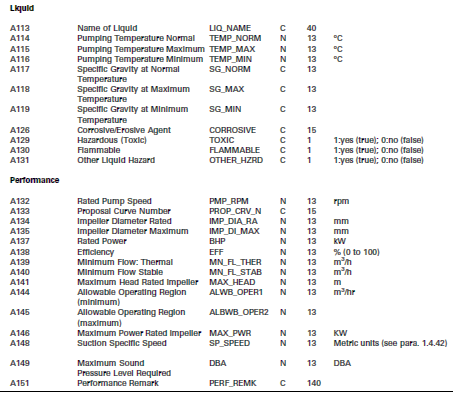Engineering design parameters are a key information class usually specified for each instrument and each item of process equipment in an engineering design application. These applications reference a very complete template for each tagged item based on ASME, API, or ISA standards. Most engineering design applications have a very complete set of templates covering most of the OEM equipment required to construct the majority of chemical, refining, or oil and gas processes with the exception of custom equipment like hydrocrackers or fluidized bed reactors, or fixed bed reactors. These devices are usually patent protected and their design parameters are not generally published. Engineering design data for these devices will have to be accessed through non-disclosure agreements by each owner operator to secure these items parameters for placeholders in an O&M Repository.
Securing the largely available public engineering design templates for as many common equipment classes as possible and using them as data element place holders secures an interoperable context for receiving information from engineering design applications. This is the primary goal for completing the near term work for this class of information. To illustrate the engineering design data concept consider the following figure that shows a snippet of the total categories and associated parameters from the ASME B73.1 – 2001: Specification for Horizontal End Suction Centrifugal Pumps for Chemical Process.

Even for these two limited categories, the parameters allow for the specification of this type of equipment without specifying a particular vendor and OEM Model number. The specification supplies general performance curves for these to specify desired efficiency, impeller size, etc. so the general operating range of the pump and its ability to handle the required fluids going through it can be specified without resorting to a vendor catalogue search. The design specification is very complete to enable an engineer to specify almost any pump requirements for pumps of this type, and there are appropriate data place holders for the range of equipment without inventing new parameters. By using this specification format for engineering design parameters organized into a category and attribute template for storage in the O&M Repository for pumps of this type, you would have a high probability of having a deterministic data format to place design information with confidence that you will not have a piece of information come to you that cannot fit in the template. In fact, this is exactly what engineering design system vendors do to cover a very high percentage of their equipment specifications with most of the templates being based on existing standards (ASME, API, ISA, etc.) covering thousands of equipment types – pumps, heat exchangers, vessels, pipe segments, pressure parts, distillation columns, instrument measurement elements, instrument loop components (e.g. controllers, transmitters, etc.). Also these templates can be exported in XML format, or at the very least, exported in some organized file format.
In the near term, work in the OGI Pilot will involve gathering templates from the engineering design vendors for all equipment and instrument types, comparing them and ensuring that these types and parameters are covered in the ISO 15926 Reference Data Library (RDL) and grouped in a similar fashion. If they are not present, they are to be submitted to PCA to ensure that the RDL contains a superset of design specification parameters and templates that are useful, documented, and acceptable by all parties.



